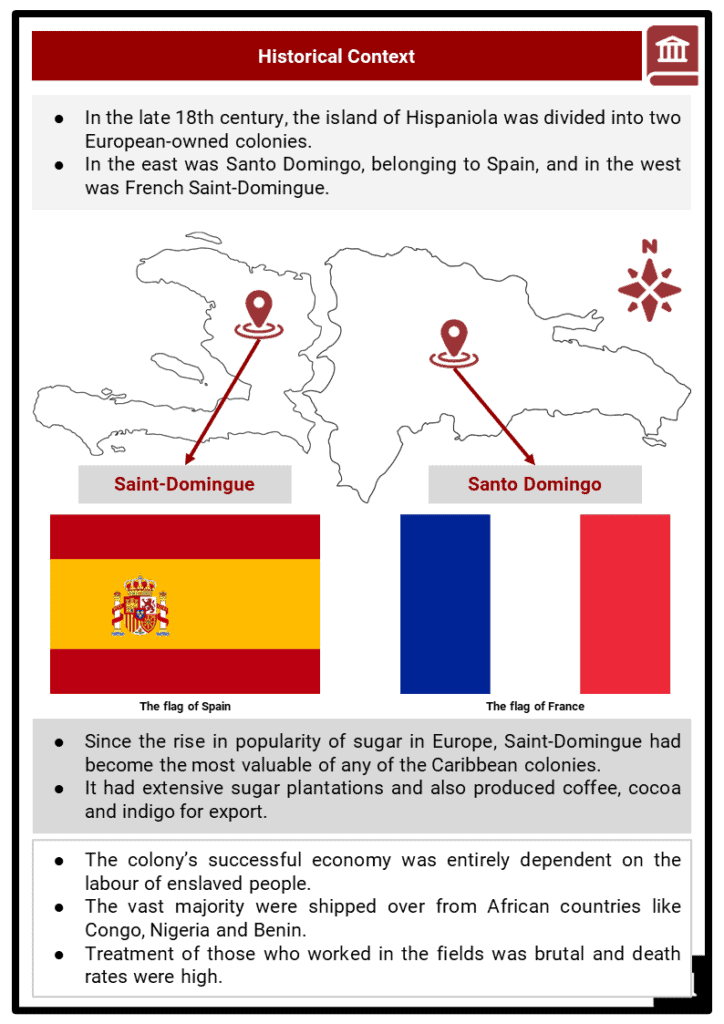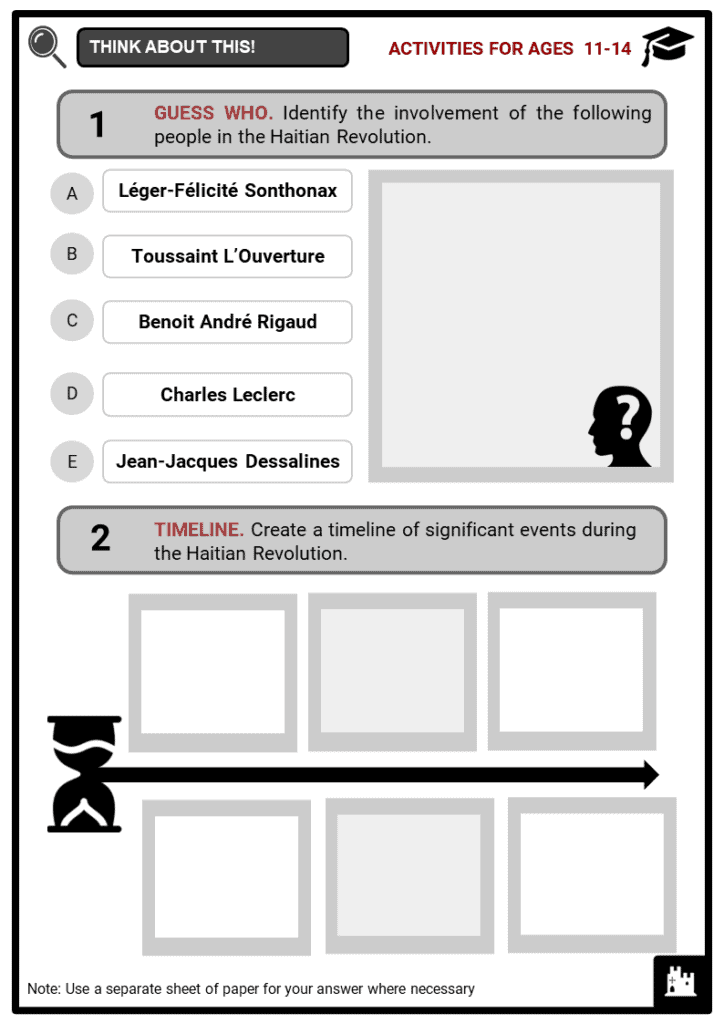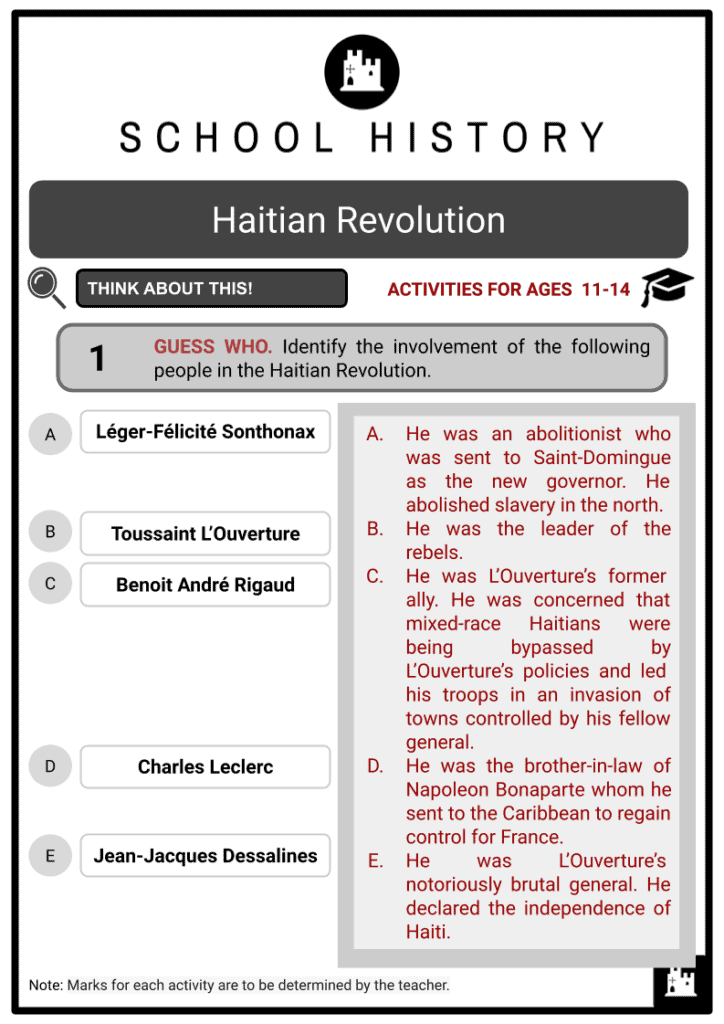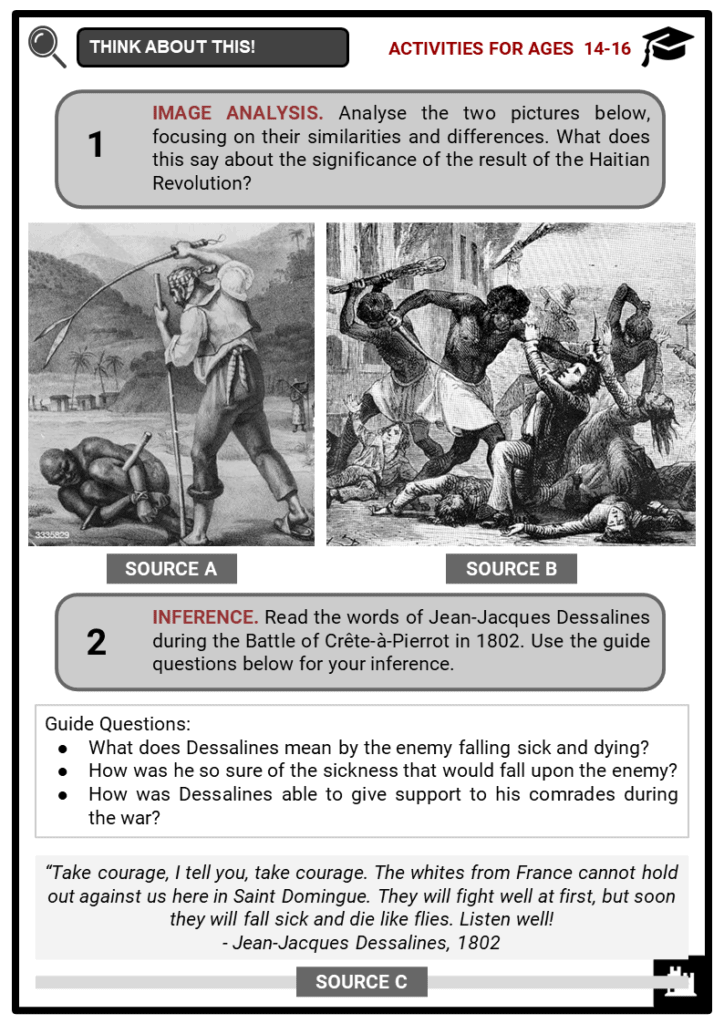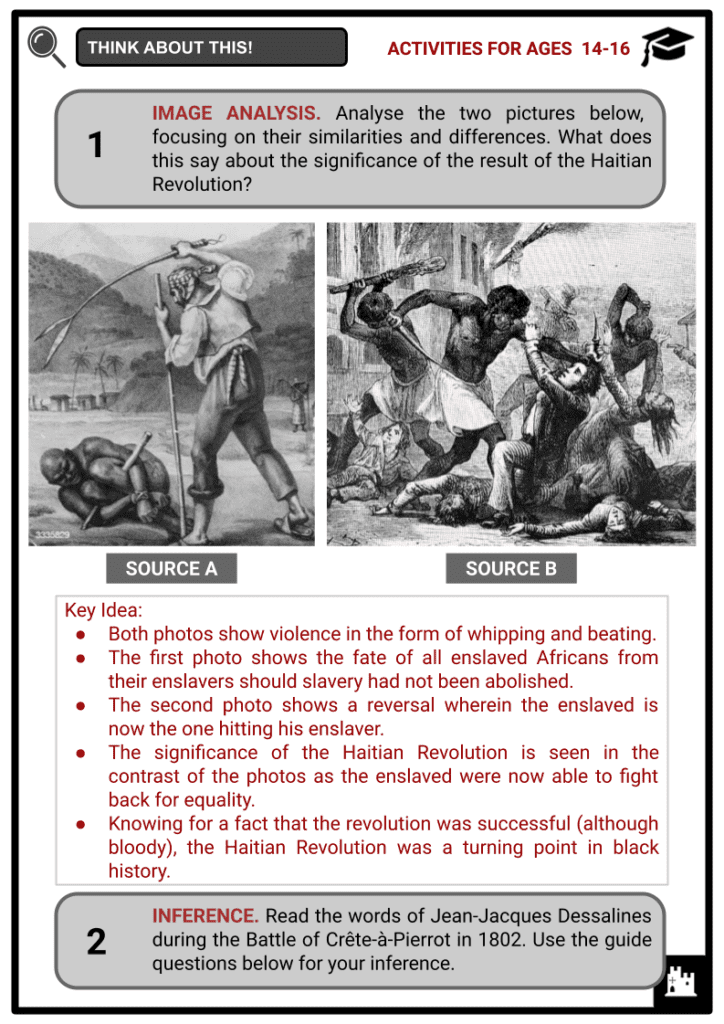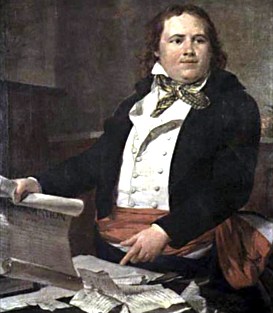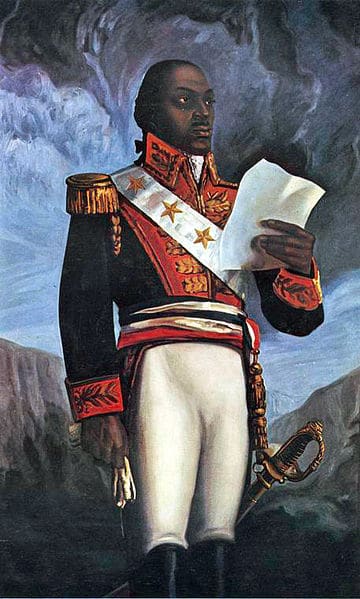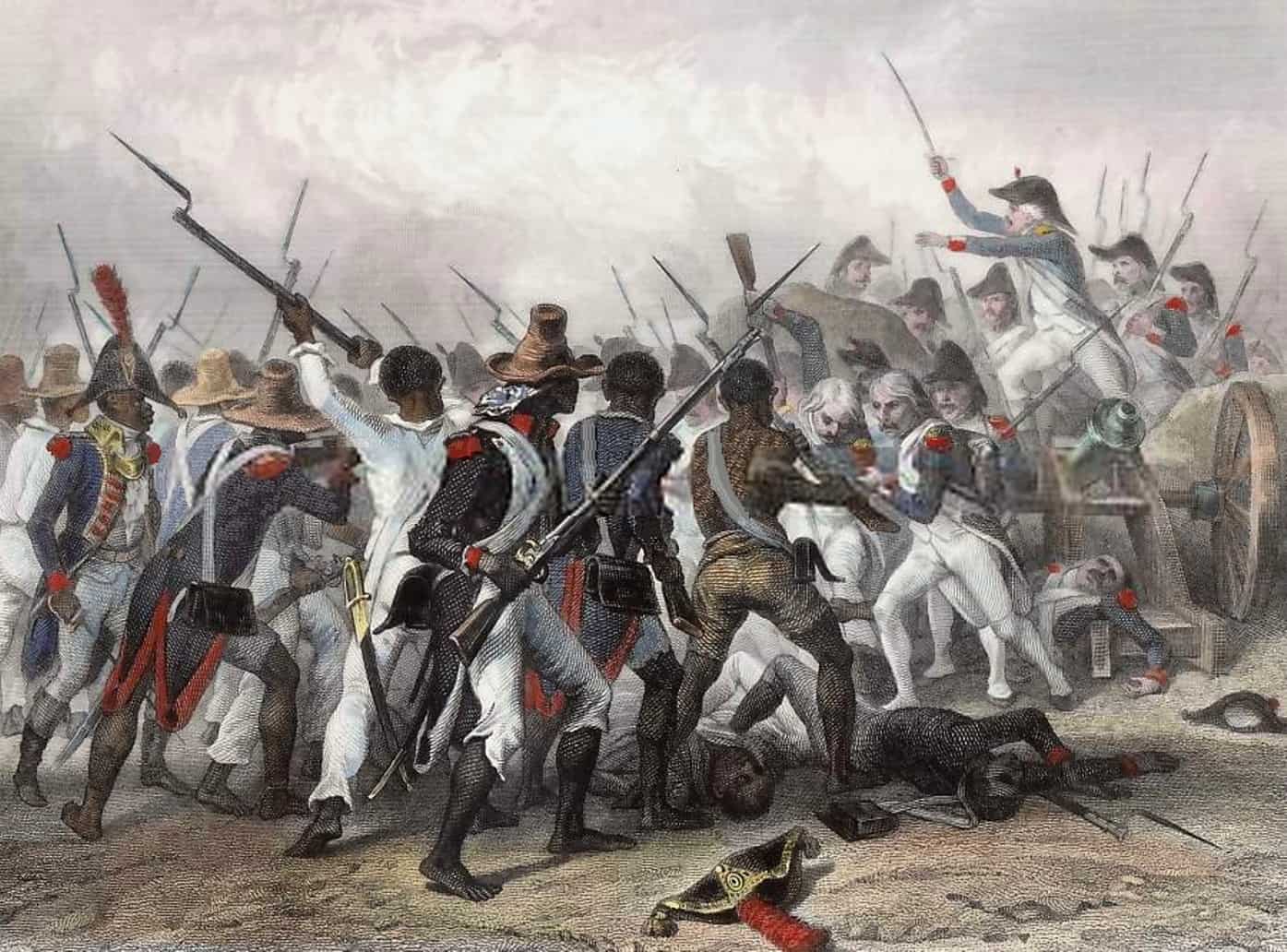Download Haitian Revolution Worksheets
Do you want to save dozens of hours in time? Get your evenings and weekends back? Be able to teach Haitian Revolution to your students?
Our worksheet bundle includes a fact file and printable worksheets and student activities. Perfect for both the classroom and homeschooling!
Summary
- The historical context of the Haitian Revolution: the impact of slavery
- The timeline of important events in the rebellion
- The fight for independence
Key Facts And Information
Let’s know more about Haitian Revolution!
- Haiti, formerly known as Saint-Domingue, was a French colony whose wealth depended on slavery. Society in Saint-Domingue was rigidly hierarchical and violence was commonplace. The vast majority of the population were enslaved Africans. The Haitian Revolution was a series of conflicts from 1791 to 1804 that resulted in a successful rebellion by the enslaved Africans against the French colonial rule in Saint-Domingue. The rebellion was the only successful revolt by enslaved black people.
Historical Context
- In the late 18th century, the island of Hispaniola was divided into two European-owned colonies.
- In the east was Santo Domingo, belonging to Spain, and in the west was French Saint-Domingue.
- Since the rise in popularity of sugar in Europe, Saint-Domingue had become the most valuable of any of the Caribbean colonies.
- It had extensive sugar plantations and also produced coffee, cocoa and indigo for export.
- The colony’s successful economy was entirely dependent on the labour of enslaved people.
- The vast majority were shipped over from African countries like Congo, Nigeria and Benin.
- Treatment of those who worked in the fields was brutal and death rates were high.
- In 1789, the French Revolution overthrew the monarchy and proclaimed that all men should be free and equal.
- In Saint-Domingue, campaigners argued that this should apply to all people regardless of the colour of their skin.
- After personal appeals by people of colour from Saint-Domingue, in 1791, the National Assembly in Paris granted citizenship to people of colour born to free parents.
A Timeline of Important Events in the Haitian Revolution
The Haitian Revolution is often described as the only successful slave rebellion. The revolt began in 1791 by enslaved people against French colonial rule in Saint-Domingue (present-day Haiti). It went on through a series of conflicts that finally ended in 1804 with Haiti’s independence.
- 1791 - The enslaved people in Saint-Domingue rose up and attacked their enslavers. Toussaint L’Ouverture emerged as the leader of the rebels.
- 1794 - The French government officially freed all enslaved people in its colonies and made them full citizens.
- 1798 - The British negotiated a truce with L’Ouverture, promising not to return to Saint -Domingue.
- 1799 - Toussaint L’Ouverture had to face an enemy from within, his former ally Benoit André Rigaud. Their conflict was referred to as the War of Knives and lasted until 1800.
- 1801 - Fearing that the new French emperor Napoleon Bonaparte would reintroduce slavery, Toussaint L’Ouverture drew up a constitution for the island of Hispaniola that outlawed slavery.
- 1802 - Battles for independence namely Ravine-à-Couleuvres and Crête-à- Pierrot took place.
- 1803 - Toussaint L’Ouverture’s death in prison after he was betrayed, captured and sent to France. This year also marked the final battle of the Haitian Revolution, at Vertières.
- 1804 - In the city of Gonaives, Jean- Jacques Dessalines declared independence for the new state of Haiti.
The Rebellion
- On the night of 21st August 1791, at a secret voodoo ceremony, the signal was given for an uprising to begin.
- Enslaved people throughout the northern province of Saint-Domingue turned on their white enslavers, and thousands were killed.
- Plantations were destroyed and the damage ran to millions of francs.
- By September, some of the surviving white people on Saint-Domingue had organised a fightback, and many thousands of black people were killed.
- In response to the crisis, the French government sent soldiers to restore order and a new governor for the colony, the abolitionist Léger-Félicité Sonthonax.
- He abolished slavery in the north of Saint-Domingue.
- By 1793, France was at war with Britain and Spain, countries which also had a strong presence in the Caribbean.
- Spain owned the territory bordering Saint-Domingue, and Britain had colonies in several other islands and was keen to use Saint-Domingue to weaken the French economically.
- Both Britain and Spain kept the rebels on Saint-Domingue supplied with arms, and British troops even managed to enter the colony and take over a French naval base.
- Governor Sontomax realised that, if the rebels were given what they wanted, they might unite with the French army again to drive the enemy out of Saint-Domingue.
- He sent representatives from the colony to Paris to put the case for the abolition of slavery.
- Their arguments were successful, and the French government agreed to free all slaves in its colonies and make them citizens of France.
- Rebel leader Toussaint L’Ouverture had been fighting with the Spanish army against the French, but he changed allegiance back to France following the abolition.
- His goal had been achieved.
- The British and Spanish troops had been prevailing against the French in Saint-Domingue, but they were starting to succumb to yellow fever, a disease that was rife in the region at certain times in the year and caused thousands of deaths among foreigners.
- The effects of yellow fever, the high costs of the campaign, and the impressive fighting skills of the Haitians under L’Ouverture all led people at home in Britain to question whether it was worth continuing to throw men and money at the military efforts.
- Eventually, in 1798, the British negotiated a truce with L’Ouverture, promising not to return to Saint-Domingue.
- In return, L’Ouverture agreed not to encourage slave rebellions in any of Britain’s own Caribbean colonies.
- In 1799, Toussaint L’Ouverture had to face an enemy from within, his former ally Benoit André Rigaud.
- Rigaud was a free person of colour who controlled the southern province of Saint-Domingue.
- He was concerned that mixed-race Haitians were being bypassed by L’Ouverture’s policies and led his troops in an invasion of towns controlled by his fellow general.
- At the same time, he encouraged uprisings against L’Ouverture in the north.
- The conflict between the two became known as the War of Knives and lasted until 1800.
- L’Ouverture had forged trading ties with the United States, and was able to call on them to help him by sending ships to blockade ports controlled by Rigaud.
- L’Ouverture also had a strong numerical advantage over Rigaud’s forces, and so was able to prevail over his rival, who was forced to flee to France.
- In the aftermath of the War of Knives, L’Ouverture took the opportunity to invade the Spanish-held Santo Domingo to the east.
- He believed that the colony had supported Rigaud, and also claimed that it was kidnapping black people from Saint-Domingue and selling them into slavery.
- Taking control of Santo Domingo with relative ease, and having overcome his rivals in Saint-Domingue, Toussaint L’Ouverture was now the de facto ruler of the entire island of Hispaniola, although officially he answered to the French.
- In practice, however, his negotiation of a truce with Britain and a trade agreement with the United States showed that he was acting as leader of an independent state.
- In 1801, fearing that the new French emperor Napoleon Bonaparte would reintroduce slavery, Toussaint L’Ouverture drew up a constitution for the island of Hispaniola.
- Although he acknowledged that it remained a colony of France, he did not give France any trade advantages over other nations.
- He also declared that slavery would never be brought back, and named himself Governor for life.
- The audacity of L’Ouverture in publishing his constitution angered Napoleon, who sent troops led by his brother-in-law Charles Leclerc to the Caribbean to regain control for France.
The Fight for Independence
- When Napoleon’s troops arrived in Saint-Domingue, the Haitians adopted a scorched-earth policy.
- This is a policy that aimed to destroy any assets that could be useful to the enemy.
- Thus, the Haitians only conceded territory when they had made sure that the French could not use it to supply their army with shelter or food.
- L’Ouverture and his generals now commanded armies that were experienced, more resistant to disease, and could use their terrain effectively.
- The battles of Ravine-à-Couleuvres and Crête-à-Pierrot in 1802 showed that, even when the French eventually prevailed, they would suffer heavy losses.
- Some ordinary soldiers had sympathy with their Haitian opponents, whose cause had its roots in the principles of the French Revolution.
- After one of his generals, Henry Christophe, defected to the French, Toussaint L’Ouverture agreed to negotiate.
- He stood down his troops in exchange for the guarantee that slavery would not be restored.
- However, he was betrayed, captured and sent to France.
- He died in prison there in 1803.
- In Saint-Domingue, the war against the French resumed.
- Jean-Jacques Dessalines, L’Ouverture’s notoriously brutal general, and Alexandre Pétion, a former ally of Rigaud’s, conducted a campaign of guerrilla warfare, fearing that the French authorities would reintroduce slavery.
- The departure of L’Ouverture saw atrocities on both sides and reached a new and terrible level.
- By 1803, Napoleon was facing war on several fronts. British ships blockaded the French in Saint-Domingue and assisted Haitian troops.
- November 1803 saw the final battle of the Haitian Revolution, at Vertières. Dessalines was triumphant, and the French troops remaining on the island were forced to surrender to the British just to ensure their safe passage away.
- On the 1st of January 1804, in the city of Gonaives, Jean-Jacques Dessalines declared independence for the new state of Haiti.
- The name came from a pre-colonial indigenous language.
- Haiti was the first state to be founded and ruled by a formerly enslaved, and the first independent Latin American nation in the modern era.
Image sources:
[1.] https://upload.wikimedia.org/wikipedia/commons/1/16/Mapa_colonial_de_la_Isla_de_Santo_Domingo.gif
[2.] https://upload.wikimedia.org/wikipedia/commons/0/09/Sonthonax.jpg
[4.] https://upload.wikimedia.org/wikipedia/commons/c/c0/Haitian_Revolution.jpg


